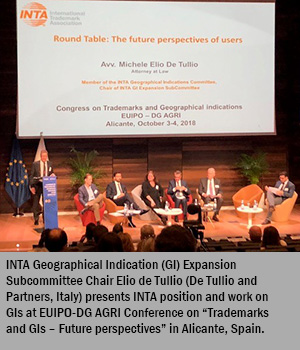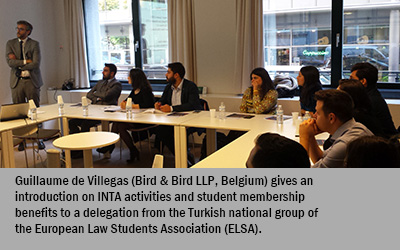Brexit: Preparing for a ‘No Deal’
Published: October 15, 2018
 The clock is ticking ahead of “Brexit Day,” which is set for March 29, 2019, and before the “last chance” European Union (EU) Summit from October 17 to 19, to agree on a final deal. While the endgame approaches, and given the lack of substantial progress so far, a “no deal” scenario becomes more and more likely-a scenario that United Kingdom (UK) Prime Minister Theresa May evoked at her Tory Party conference on October 3: “If we all go off in different directions in pursuit of our own visions of the perfect Brexit, we risk ending up with no Brexit at all.” In that context, the UK government on September 24 published the first wave of technical guidelines, including those pertaining to intellectual property (IP) rights in case of a “No Deal” Brexit. These cover trademarks and designs, geographical indications (GIs), copyrights, exhaustion of rights, and patents.
The clock is ticking ahead of “Brexit Day,” which is set for March 29, 2019, and before the “last chance” European Union (EU) Summit from October 17 to 19, to agree on a final deal. While the endgame approaches, and given the lack of substantial progress so far, a “no deal” scenario becomes more and more likely-a scenario that United Kingdom (UK) Prime Minister Theresa May evoked at her Tory Party conference on October 3: “If we all go off in different directions in pursuit of our own visions of the perfect Brexit, we risk ending up with no Brexit at all.” In that context, the UK government on September 24 published the first wave of technical guidelines, including those pertaining to intellectual property (IP) rights in case of a “No Deal” Brexit. These cover trademarks and designs, geographical indications (GIs), copyrights, exhaustion of rights, and patents.
- On trademarks and designs, the UK will ensure that the property rights in all existing registered EU trademarks and registered European Community designs will continue to be protected and enforceable in the UK by providing an equivalent UK-registered trademark or design.
- On GIs, the UK intends to set up its own GI schemes, which will “broadly mirror the current EU regime.” The protections will be similar to those enjoyed now by UK GI producers, with all 86 UK GIs given new UK GI status automatically. The UK would no longer be required to recognize EU GI status and EU producers would be able to apply for UK GI status.Two public consultations were notably launched on October 4 regarding, on the one hand, the UK GI registration scheme and, on the other hand, on Improved Enforcement of the Protected Food Name Scheme in the UK. INTA is currently working on providing input by November 1 and November 2, respectively.
- On exhaustion, the UK will continue to recognize the European Economic Area (EEA) regional exhaustion regime from exit day. Nonetheless, regarding parallel imports, while there will be no change for the importation of goods into the UK, the UK may impose restrictions on the parallel import of goods from the UK to the EEA.
Of course, these technical notes are meant to indicate the UK’s approach in case of a no-deal, but do not prevent other solutions in case the EU and UK reach a deal on the conditions of the UK’s exit, and on the EU-UK future relationship.
INTA had several exchanges with the UK Intellectual Property Office (UKIPO) and other stakeholders to offer further recommendations on key issues. For the latest updates and more on Brexit, including INTA’s Brands Brexit Toolkit, visit INTA’s dedicated webpage.
Important Changes Foreseen at the European Observatory on Infringements and Intellectual Property Rights
INTA provided comments and additional comments on the European Commission’s first ever consultation on the evaluation of the Observatory since its creation in 2012, as well as input regarding the European Observatory on Infringements and Intellectual Property Rights’ Multiannual Plan Extension and Work Programme for 2019 . Hélène Nicora, INTA Chief Representative Officer for Europe, attended the Observatory’s plenary session in Alicante, Spain, from September 26 to 27, where the above topics were discussed. The question of the restructuring of the Observatory’s working groups (WGs) was at the cornerstone of the three points mentioned above. After several proposals, the Observatory now intends to put forward the following new structure:
- Keeping four existing WGs as they are: Enforcement, Public Awareness, IP in the Digital World, and Economics and Statistics (INTA has been represented in all so far);
- In addition, and in parallel, creating six expert groups: Legal, International Cooperation (a split from the previous “Legal and International” WG), Impact of Technology, Cooperation with intermediaries, Observatory Outreach, and small and medium-size enterprises.
The expert groups will be small in number (around 30 members) and limited to experts. The final proposal should be put forward for approval at the meeting of the Management Board and Budget Committee (MBBC) of the European Union Intellectual Property Office (EUIPO) on November 20-22, while the last session of the five current WGs will take place in Warsaw, Poland, November 26‒30.
It is worth noting that in September, the Observatory published a Study on legislative measures related to online IPR infringements. This study’s main purpose is to establish whether and to what extent a number of specific legislative measures, which can be applied to prevent or combat IP rights (IPR) infringement in the online environment, are available in EU member states.
 INTA Speaks on Trademarks and Geographical Indications
INTA Speaks on Trademarks and Geographical Indications
On October 3 and 4, Elio de Tullio (De Tullio and Partners, Italy), chair of the GI Expansion Subcommittee, and Hadrien Valembois, INTA Europe Policy Officer, attended the EUIPO-EU Commission’s Directorate-General “Agriculture and Rural Development” (DG AGRI) “Trademark and Geographical Indications-Future Perspectives” Conference in Alicante, Spain. Mr. de Tullio spoke on a panel titled “The Future Perspectives of Users.” He notably stressed the “first in time, first in right” principle to solve potential conflicts between trademarks and GIs, while reminding attendees that, in the majority of the cases, trademarks and GIs are complementary.
For its part, the European Commission announced the launch of a study on the economic aspects of GI sui generis protection in October 2018, with a final report expected by January 2019.
Europe Office Works with WIPO, European Commission, National Offices, and EUIPO
In a meeting in Brussels on September 19 with Program Officer Monika Zikova and the Department for Transition and Developed Countries, INTA learned that the World Intellectual Property Organization (WIPO) is currently setting up a single common Global IP Platform that consolidates the customer experience, revenue management, and data assets capture and management across the business lines and associated information and communications technology (ICT) systems. WIPO is looking for brand owners willing to provide detailed input on the pilot platform.
On October 2, INTA’s Europe Office attended a meeting organized by the Directorate-General for Trade of the European Commission (DG TRADE) in Brussels to exchange with stakeholders on the 2019 Work Plan for the EU IP Key programs. Financed by the European Commission, the IP Key programs are implemented by the EUIPO to support robust IP systems in China, Latin America, and Southeast Asia. More information on trainings, seminars, and projects foreseen in the different regions can be found at https://ipkey.eu/en.
INTA is also strengthening its relationship with EU national IP offices. Ms. Nicora discussed IP strategies, the impact of new technologies, and the role of IP offices in a changing European landscape with the heads of the IP offices of Estonia, Latvia, Lithuania, Hungary, Poland, Sweden, and the UK in Geneva, Switzerland, on September 24 and 25. On October 10, on the margins of an EUIPO Regional Seminar, Andrea Klein (Akran Intellectual Property, Italy), chair of INTA’s Trademark Office Practices-European National Offices Subcommittee, and INTA’s Europe Policy Officer Carolina Oliveira met with the Head of the Trademarks Division of the Italian Patent and Trademark Office (UIBM), Alfonso Piantedosi, to exchange views on the UIBM’s practices and the implementation of the Trade Marks Directive in Italy.
INTA remains very active in the EUIPO. From October 16 to 18, Europe Policy Officer Carolina Oliveira, together with Bénédicte Linden (LINDEN Legal Consulting, Belgium), chair of INTA’s Trademark Office Practices-EUIPO Subcommittee, and IvÁn Sempere (PADIMA, Spain), chair of INTA’s Designs-Design Law and Practice Subcommittee, will attend, respectively, the EUIPO 20th Liaison Meeting on Trade Marks and the 17th Liaison Meeting on Designs, in Alicante, Spain. The EUIPO will provide an update on the implementation of the trademark legislative reform, the state of play on the EU legislation on designs, recent practices and case law, as well as the different European cooperation projects, including convergence of practices among the EUIPO and EU member states on “Examination of Formal Requirements and Grounds of Refusal for New Types of Marks” (so-called Working Group CP11) and on the “Disclosure of Designs on the Internet” (CP10). INTA is represented in nine EUIPO cooperation projects, including CP11 and CP10.
Blockchain: INTA Pushes for Consideration of Intellectual Property in EU Parliament’s Ongoing Report
In line with its strategic priority on innovation, INTA is looking into the European Parliament’s ongoing “own initiative” draft report (non-legislative) on “Blockchain: A Forward-Looking Trade Policy.” INTA advocates for the report to request that any upcoming EU strategy or legislation on blockchain specifically considers IP and, notably, its use in the fight against counterfeiting.
 INTA Welcomes Law Students from Turkey
INTA Welcomes Law Students from Turkey
On October 4, at INTA’s Europe Office in Brussels, Guillaume de Villegas (Bird & Bird LLP, Belgium), accompanied by his colleague Charlotte Haine, gave a lecture on trademark law to 13 law students from the Turkish national group of the European Law Students Association (ELSA), coming from universities of Ankara, Istanbul, and Izmir. The ELSA students’ visit to INTA was part of a long study trip to visit the EU institutions and is now a regular feature, with the objective of raising the interest of law students in trademark law.
Afterwards, Milesh Gordhandas, Advisor, Europe Office, gave a short introduction on INTA, its academic activities, and student membership benefits. Mr. de Villegas challenged the students on whether they could guess the correct trademarks based on logos alone. He talked about his career path, the basics of trademark law through real-life examples, and the various career paths of a trademark practitioner. Students were interested in what could or could not be registered as a trademark and the protection of products based on artificial intelligence.
INTA’s Europe Representative Office, based in Brussels, Belgium, represents the Association’s 1,800+ members across Europe (including those in EU and non-EU member states, and Russia and the Commonwealth of Independent States). Working in collaboration with staff at INTA’s headquarters in New York City, the Europe Representative Office leads the Association’s policy, membership, marketing, and communications initiatives throughout the region. To learn more about INTA’s activities in Europe, please contact INTA Chief Europe Representative Officer Hélène Nicora at [email protected] and follow us on Twitter at @INTABrussels.
Although every effort has been made to verify the accuracy of items in the INTA Bulletin, readers are urged to check independently on matters of specific concern or interest. Law & Practice updates are published without comment from INTA except where it has taken an official position.
© 2018 International Trademark Association
This website uses cookies so that we can provide you with the best user experience possible. Cookie information is stored in your browser and performs functions such as recognising you when you return to our website and helping our team to understand which sections of the website you find most interesting and useful.
To find out more please see our Cookies Policy and Privacy Policy.
These cookies are used to identify a user’s browser as the visitor goes from page to page on the Site. These are session cookies, which means that the cookie is deleted when you leave the Site. It is an integral piece of the Site software and used to let the server know which users are on the Site at any given time and make certain parts of the Site easier to use.
|
|
If you disable this cookie, we will not be able to save your preferences. This means that every time you visit this website you will need to enable or disable cookies again.
These cookies are used to collect information about how visitors use our Site. The cookies collect information in anonymous form, including the numbers of visitors to the Site, where visitors have come to the Site from, the pages they visited and how they have interacted with tools on the Site like search and embedded media players. We use the information to compile statistical reports of our users’ browsing patterns so that we can improve the Site.
|
|
Please enable Functionality Cookies first so that we can save your preferences!
These cookies are used to deliver advertising relevant to the interests of visitors to our Site. They are persistent, which means they will remain on your device after you leave the Site.
- Facebook (Ad Pixel)
- Google (Ad Pixel)
- LinkedIn (Ad Pixel)
- Quattro Anonymous
Please enable Functionality Cookies first so that we can save your preferences!
